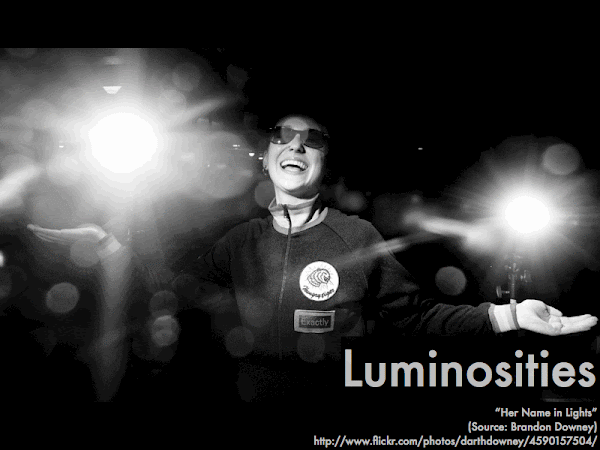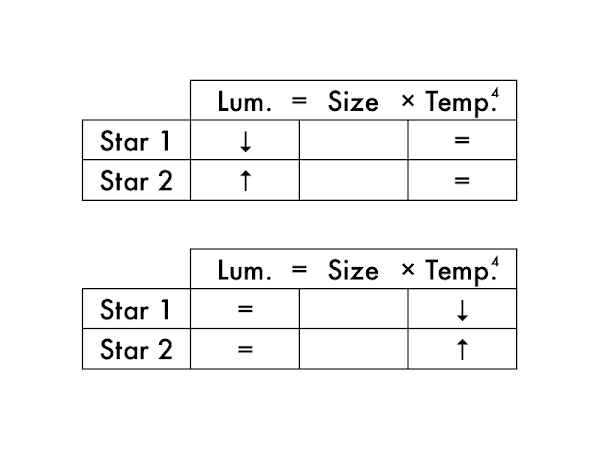Cuesta College, San Luis Obispo, CA
Students have a weekly online reading assignment (hosted by SurveyMonkey.com), where they answer questions based on reading their textbook, material covered in previous lectures, opinion questions, and/or asking (anonymous) questions or making (anonymous) comments. Full credit is given for completing the online reading assignment before next week's lecture, regardless if whether their answers are correct/incorrect. Selected results/questions/comments are addressed by the instructor at the start of the following lecture.
The following questions were asked on reading textbook chapters and previewing presentations on parallax, distance, apparent magnitude, absolute magnitude, Wien's law and the Stefan-Boltzmann law, and a TED-Ed talk on stellar properties.

Selected/edited responses are given below.
Describe something you found interesting from the assigned textbook reading or presentation preview, and explain why this was personally interesting for you.
"Intrinsic brightness, because I never knew that there was a way to find the true brightness of a star. Another interesting fact is that you eyes respond to the visual wavelength energy falling on your retina--eyes have always been interesting to me. So the fact that brightness is related to the flux of energy entering your eyes intrigues me. Energy and how you see things also involves how you see stars."
"That we can see stars that are much farther away than the sun clearly in the night sky."
"I know that the distance of a star can be determined with the use of a parallax."
"The brightness scale wasn’t so interesting until I saw what level the sun was on. If –1 is considered 'very bright' and the sun is a −27... that is just mind blowing. Just the thought of how much energy goes into emiting that much heat and light is hard to fathom."
"That the sun is not the brightness star in the sky. Mind blown."
"How the distance of stars is measured. I think it is really cool to see that kind of math used in real-world applications and on such a large scale."
"I really liked learning the connection between temperatures and colors for stars, it seemed easy to remember."
"Wien's law, because it actually explains how differing wavelengths make hotter objects appear bluer and why cooler objects appear more red."
"The different spectral classes were interesting. I didn't know there were different classifications for various temperatures of stars."
"I thought it was interesting about the colors relating to the temperature and the hottest being blue because most would think red is the hottest."
"I found Wien's law and the Stefan-Boltzmann law to be fairly interesting because it generally makes sense. I think its interesting how the opposite colors from what we would typically think of correlate with the hotter and cooler temperatures."
"I thought it was interesting how we can tell how big the stars are by their color."
Describe something you found confusing from the assigned textbook reading or presentation preview, and explain why this was personally confusing for you.
"stellar parallax. half the total shift of a star? Also, absolute visual magnitude."
"I found the parsecs and parallax completely confusing. I don't really get what parallax is at all and I just need further explanations on parsec. I found these more challenging because it's not clicking."
"Confused on the absolute magnitude and how you measure the brightness of a star very far away. What's the deal with the plus and minus in front of the numbers."
"Extremely confused on absolute magnitude and how it relates to parsecs and brightness."
"I am really confused on how apparent magnitude works."
"I can't seem to understand the difference in magnitudes. I don’t get what the 10 pcs difference is and how that gives you apparent or absolute magnitude. Just further clarification on what a pcs is would help a lot."
"It was difficult for me to understand how one star can seem larger if the other star is slightly colder or hotter?"
"Luminosity, size, and temperature of a star are concepts that are a bit difficult for me to understand."
"I didn't really find anything confusing."
"Nothing seemed confusing this week."
Explain how apparent magnitude and the absolute magnitude are defined differently.
"the scale of apparent magnitude only tells you how bright stars appear to you on Earth. Absolute magnitude is the apparent visual magnitude the star would have if it were 10 parsecs away."
"Apparent magnitude is how bright a star is from earths view vs absolute which is how bright the star actually is."
"Apparent magnitude is how bright a star is without regards to distance, and absolute magnitude is how bright a star is taking distance into consideration."
"Apparent is what we see and absolute is what it is."
Suppose the sun was moved to a distance of 10 parsecs away. As a result, its __________ magnitude would become dimmer.
absolute. ******** [8] apparent. ****************** [18] (Both of the above choices.) [0] (Neither of the above choices.) [0] (Unsure/guessing/lost/help!) ** [2]

(Only correct responses shown.)
1 (brightest): the sun, m = –27 [82%]
2: Canopus, m = –1 [71%]
3: Vega, m = 0 [71%]
4 (dimmest): Kapteyn's star, m = +9 [75%]
Rank the brightnesses of these stars (1 = brightest, 4 = dimmest; there are no ties), if relocated to 10 parsecs from Earth.
(Only correct responses shown.)
1 (brightest): Canopus, M = –3 [68%]
2: Vega, M = +0.5 [64%]
3: the sun, M = +5 [61%]
4 (dimmest): Kapteyn's star, M = +11 [68%]
Determine whether these stars get dimmer or brighter when relocated from their original positions to 10 parsecs from Earth.
(Only correct responses shown.)
The sun: gets dimmer [79%]
Canopus: gets brighter [68%]
Vega: gets dimmer [39%]
Kapteyn's star: gets dimmer [39%]
Rank the temperatures of these main sequence stars (1 = hottest, 4 = coolest; there are no ties).
(Only correct responses shown.)
Hottest: blue main sequence star [75%]
Second hottest: white main sequence star [64%]
Third hottest: yellow main sequence star [82%]
Coolest: red main sequence star [75%]
Rank the temperatures of these supergiant and dwarf stars (1 = hottest, 4 = coolest; there are no ties).
(Only correct responses shown.)
Hottest: blue supergiant [75%]
Second hottest: white dwarf [46%]
Third hottest: yellow supergiant [64%]
Coolest: red dwarf [78%]

dimmer. ***** [5] brighter. ******************* [19] (These stars would be the same size.) ** [2] (Unsure/guessing/lost/help!) ** [2]
Two stars (equally far away) have the same brightness, but one star is cooler, and the other star is hotter. The __________ star will be larger in size.
cooler. ************** [14] hotter. ********* [9] (These stars would be the same size.) * [1] (Unsure/guessing/lost/help!) **** [4]
Ask the instructor an anonymous question, or make a comment. Selected questions/comments may be discussed in class.
"I don't understand this chapter at all..."
"Can we review the above questions in class, please?" (Yes, we will have to.)
"HELP! Lost."
"Why is it that negative magnitude is brighter?" (The original Greek scale has +1 for the brightest stars, and +6 for the dimmest stars. If the smaller number for brighter stars bothers you, think of ranking schemes (as did the Greeks), where the brightest stars were "first place" or "top tier" stars, and the dimmest stars are in "sixth place." And the scale did need to get revised, as there a few stars that blow the top off the original +1 to +6 scale. Brighter than the "first place" +1 stars are "zero place" stars, and brighter than those stars are "-1 place" stars. So negative values are the hella bright stars.)
"What is a way we can wrap our mind around the distance and sizes of stars?" (We'll introduce a way of conceptually "moving" stars around from their actual locations to the "fair comparison" distance of 10 parsecs, as related to their apparent and absolute magnitudes.)
"Are there more extra-credit opportunities?" (A few more might be coming your way, both in-class and online.)
"Is the material in this half of the class easier or harder than what we learned before the first midterm? (The type of material covered in the rest of this semester will be different. Whether that's easier or harder depends on your learning style for more traditional science stuff (law, equations) instead of the spatial reasoning stuff (starwheels, lunar phases) that we've been doing so far.)
No comments:
Post a Comment